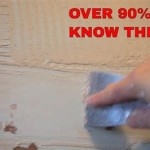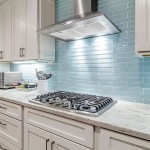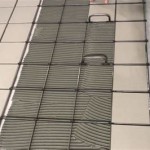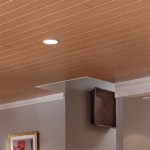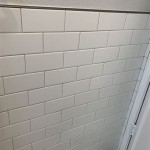Can You Put Backsplash Tile On Painted Drywall Ceilings In Kitchen?
The question of applying backsplash tile to a painted drywall ceiling in a kitchen is a complex one, fraught with potential challenges and requiring careful consideration. While the idea of a tiled ceiling might seem aesthetically appealing, particularly in specific design contexts, its feasibility and long-term success hinge on several factors, primarily concerning the structural integrity of the ceiling, the adhesion capabilities of the chosen materials, and the environmental conditions within the kitchen.
Before embarking on such a project, it is crucial to understand the inherent limitations of drywall in supporting the weight of tile, especially when applied to a horizontal surface. Ceilings, unlike walls, are subject to the constant pull of gravity, meaning any affixed material must be securely bonded to prevent detachment and potential safety hazards. This article will explore the critical considerations involved in tiling a painted drywall ceiling in a kitchen, highlighting the potential pitfalls and outlining the necessary precautions to ensure a successful, lasting installation.
Weight Considerations and Structural Integrity
The primary concern with tiling any surface, especially a ceiling, is weight. Drywall is not inherently designed to support significant loads, and adding the weight of tile, mortar, and grout can easily exceed its load-bearing capacity. The weight of the tile itself is a crucial factor. Larger, heavier tiles, such as natural stone or porcelain, pose a greater risk than smaller, lighter tiles like glass or ceramic. The type of mortar used also contributes to the overall weight. Modified thin-set mortars, while offering superior adhesion, can be heavier than traditional options.
The existing framing of the ceiling plays a crucial role in determining its load-bearing capacity. Standard drywall ceilings are typically framed with joists spaced 16 or 24 inches apart. The wider the spacing, the less weight the ceiling can safely support. If the joists are inadequately sized or spaced, they may require reinforcement before tiling. This could involve adding additional joists, sistering existing joists (attaching new joists alongside the old ones), or even replacing the existing framing entirely with a more robust structure.
Before proceeding with any tiling project on a drywall ceiling, a thorough inspection of the existing framing is essential. This should involve checking for any signs of sagging, cracks, or water damage, all of which can compromise the structural integrity of the ceiling. Consulting with a structural engineer is highly recommended, especially if there are any doubts about the ceiling's load-bearing capacity. A structural engineer can perform a detailed analysis of the framing and provide recommendations for reinforcement if necessary. Ignoring these considerations could lead to ceiling failure, resulting in costly repairs and potential injury.
Adhesion Challenges on Painted Drywall
Another significant challenge in tiling a painted drywall ceiling is achieving adequate adhesion. Paint, especially glossy or semi-gloss finishes, creates a smooth, non-porous surface that prevents mortar from properly bonding to the drywall. The mortar needs to penetrate the surface to create a mechanical bond, which is hindered by the presence of paint. Even if the paint seems to be well-adhered to the drywall, its bond to the drywall may not be strong enough to withstand the added weight and stress of the tile installation.
Proper surface preparation is paramount to ensuring successful adhesion. The existing paint layer must be completely removed or thoroughly roughened to create a suitable surface for the mortar to bond to. Several methods can be employed for paint removal. Chemical strippers can effectively dissolve the paint, but they often require multiple applications and proper ventilation. Sanding is another option, but it can be time-consuming and generate a significant amount of dust. Grinding with a diamond-grit grinding wheel can quickly remove the paint, but requires specialized equipment and safety precautions.
Once the paint is removed, the drywall surface should be primed with a bonding primer specifically designed for tile installations. These primers contain additives that enhance adhesion and create a suitable surface for the mortar. The primer should be applied according to the manufacturer's instructions, ensuring complete and even coverage. Allowing the primer to dry thoroughly before applying the mortar is crucial for optimal adhesion. Skipping this step can lead to tile delamination and eventual failure of the installation.
Choosing the right type of mortar is also critical. Modified thin-set mortars, which contain polymers that enhance adhesion and flexibility, are generally recommended for ceiling tile installations. These mortars are designed to withstand the constant pull of gravity and the stresses associated with temperature and humidity fluctuations. Applying the mortar correctly, using the appropriate trowel size and technique, is also essential for achieving a strong bond. The mortar should be applied in a thin, even layer, ensuring full coverage of the tile's back surface. Back-buttering the tiles, applying a thin layer of mortar directly to the back of each tile, can further enhance adhesion.
Environmental Considerations and Kitchen Conditions
Kitchens are inherently challenging environments for tile installations due to the constant exposure to moisture, heat, and grease. These factors can significantly impact the long-term performance and durability of the tiled ceiling. Steam from cooking, splatters from grease, and fluctuating temperatures can all contribute to the degradation of the mortar and grout, potentially leading to tile delamination and mold growth.
Proper ventilation is essential for minimizing the impact of moisture and heat on the tiled ceiling. A powerful range hood that effectively removes steam and odors is crucial. The range hood should be properly sized for the cooking area and vented to the outside. Regular cleaning of the range hood filters is also important for maintaining its efficiency. Inadequate ventilation can lead to a buildup of moisture and grease, which can weaken the bond between the tile and the drywall.
Selecting grout that is resistant to moisture, stains, and mold is crucial for maintaining the appearance and longevity of the tiled ceiling. Epoxy grout is generally the preferred choice for kitchen applications due to its superior durability and resistance to harsh chemicals and moisture. Cement-based grouts can be used, but they require sealing to prevent staining and water damage. Regular cleaning of the grout lines is essential for preventing the buildup of dirt, grease, and mold. A mild detergent and a soft brush can be used to clean the grout lines. For stubborn stains, a grout cleaner specifically designed for kitchens can be used. Avoid using harsh chemicals or abrasive cleaners, as these can damage the grout and the tile.
The choice of tile material should also be carefully considered in relation to the kitchen environment. Materials that are non-porous and easy to clean, such as glass or glazed ceramic, are generally preferred. Natural stone tiles, such as marble or granite, can be used, but they require sealing to prevent staining and water damage. Porous materials are more susceptible to absorbing moisture and grease, which can be difficult to remove and can lead to staining and mold growth.
Even with proper ventilation and careful material selection, a tiled ceiling in a kitchen will require regular maintenance to ensure its long-term performance and appearance. This includes routine cleaning of the tiles and grout, inspecting for any signs of damage or water intrusion, and promptly addressing any issues that are identified. Neglecting maintenance can lead to more significant problems, such as tile delamination, mold growth, and structural damage to the ceiling.
In summary, while technically possible to tile a painted drywall ceiling in a kitchen, this project demands careful planning, meticulous execution, and a thorough understanding of the potential challenges involved. The weight of the tile, the adhesion challenges on painted surfaces, and the harsh environmental conditions in kitchens all require careful consideration and mitigation. Before embarking on such a project, it is highly recommended to consult with qualified professionals, including structural engineers and experienced tile installers, to ensure a safe, successful, and lasting installation. Failure to address these key considerations can result in costly repairs, structural damage, and potential safety hazards.

Going Up Backsplash Tile That Goes To The Ceiling

How To Diy Paint Your Kitchen Backsplash Tile So It Lasts For Years Mary Jo On The Go

How I Transformed My Kitchen With Paint House Mix

Tin Tile Backsplash Ceilings Armstrong Residential

Is A Backsplash Necessary In Kitchen The Truth

Kitchen Backsplashes What Are They Do You Need Them

6 Splendid Wall Tiles Design That Can Give A New Look To Your Kitchen

Kitchen Backsplashes What Are They Do You Need Them

Tile Backsplash When There Is Existing Countertop Hometalk

Can Backsplash Go Above Cabinets
Related Posts


